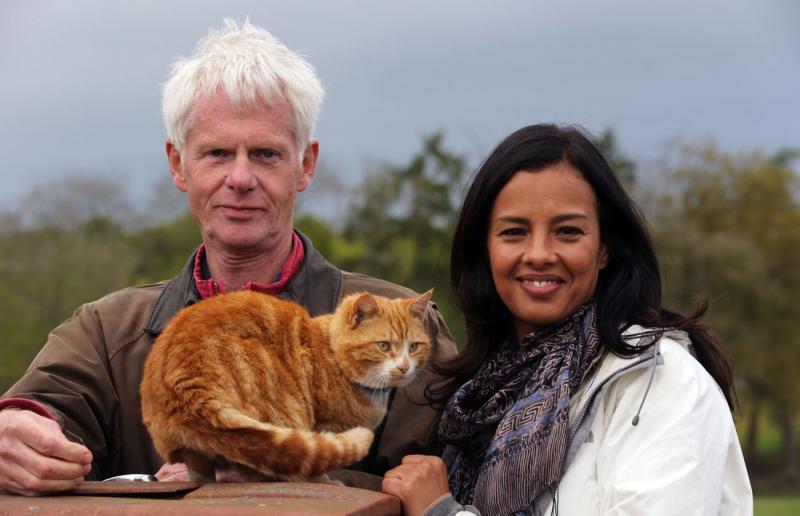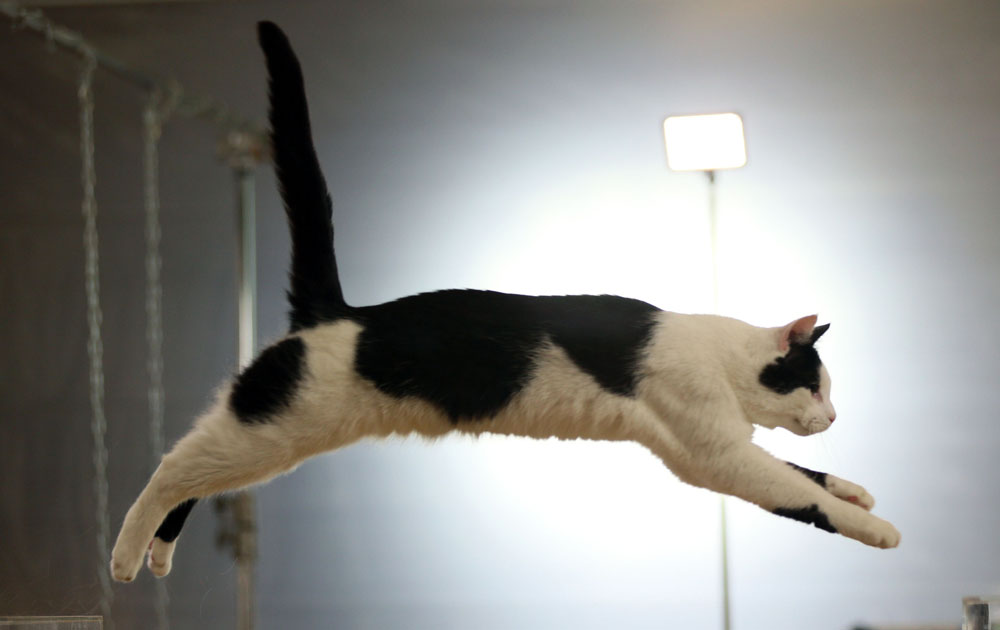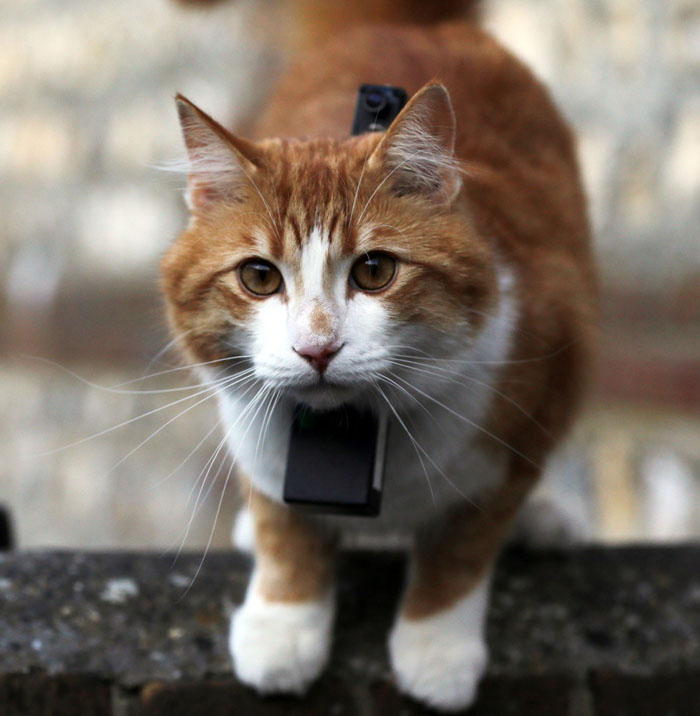Cat Watch 2014: The New Horizon Experiment, BBC Two | reviews, news & interviews
Cat Watch 2014: The New Horizon Experiment, BBC Two
Cat Watch 2014: The New Horizon Experiment, BBC Two
Latest attempt by boffins to unravel the mysteries of 'Felis catus'

Cats have had a harder time adapting to humans than humans to cats, as this remarkable examination of contemporary feline habits points out. It is not always easy changing from wild animal to feline friend, as the programme put it. Nocturnal hunters now have a life in the daytime, but they are still solo rather than pack animals.
The hundred cats under observation in this three-part study – to come are hunters at night, and the ways in which cats communicate with each other and us – were fitted with sophisticated tracking cameras, adapted for those invented for lions and cheetahs. Fixed cameras were positioned in owners' homes, gardens and farmyards to plot their movements by night and day. Cats were observed in the crowded terraces of Brighton, in the more spacious countryside around Rottingdean, and as working cats on the farm.
 We were almost entirely spared anthropomorphism, in favour of extended examination of feline sensory perception of the feline world. The data coming through on computer screens in what looked like a souped-up shed, known as Cat HQ, was analysed and explained by Professor Alan Wilson, Royal Veterinary College, vet Richard Harvey, biologist John Bradshaw and animal behaviourist Dr Sarah Ellis. The very pregnant Sarah Ellis explained that cats absolutely do not like change or anything they feel as a threat. Rottingdean Diggy indeed had left home in favour of wandering as much as five miles a day to avoid the intrusion of his family’s new human baby, who liked nothing more than pummelling the family pet. Dr Ellis however was preparing high rise refuges for her own two cats on top of bookcases – cats like heights, whence they can safely survey their kingdom – which small babies could certainly not reach, and rubbing the cats’ own scent onto baby paraphernalia from buggy to cot, to make it part of the feline furniture.
We were almost entirely spared anthropomorphism, in favour of extended examination of feline sensory perception of the feline world. The data coming through on computer screens in what looked like a souped-up shed, known as Cat HQ, was analysed and explained by Professor Alan Wilson, Royal Veterinary College, vet Richard Harvey, biologist John Bradshaw and animal behaviourist Dr Sarah Ellis. The very pregnant Sarah Ellis explained that cats absolutely do not like change or anything they feel as a threat. Rottingdean Diggy indeed had left home in favour of wandering as much as five miles a day to avoid the intrusion of his family’s new human baby, who liked nothing more than pummelling the family pet. Dr Ellis however was preparing high rise refuges for her own two cats on top of bookcases – cats like heights, whence they can safely survey their kingdom – which small babies could certainly not reach, and rubbing the cats’ own scent onto baby paraphernalia from buggy to cot, to make it part of the feline furniture.
Cat Watch examined cats’ own perceptions in detail and explained the difference between human sight, hearing, sense of smell, and balance. Along the way we took in the extraordinary role of the mobility of cats’ ears – so they can hear from any direction – and whiskers, sensing how much room there is in narrow spaces, and also exactly where the prey is at the point of capture (Tigger wearing a CatCam, pictured below).
 Cats’ vision is blurry and they only see a washed out world with little colour, but we were able to see how this apparent deprivation became an advantage at the optimum hunting times of dusk and dawn. Diagrams showed us how having five times as many rods (whatever they may be) in their eyes than humans means their lowlight vision is 40 per cent better than ours, and as nocturnal animals, cats only need one-sixth of the light we do. Their hearing is perhaps the most acute of any mammal, and 10 times better than ours. Cats hear 11 octaves, two more than humans, and the researchers had the equipment to prove it, hidden under sofas and chairs in the feline homes.
Cats’ vision is blurry and they only see a washed out world with little colour, but we were able to see how this apparent deprivation became an advantage at the optimum hunting times of dusk and dawn. Diagrams showed us how having five times as many rods (whatever they may be) in their eyes than humans means their lowlight vision is 40 per cent better than ours, and as nocturnal animals, cats only need one-sixth of the light we do. Their hearing is perhaps the most acute of any mammal, and 10 times better than ours. Cats hear 11 octaves, two more than humans, and the researchers had the equipment to prove it, hidden under sofas and chairs in the feline homes.
The real mystery though is how the researchers got so much feline co-operation; the collars were not displaced, and they were easily seduced into playtime. It was nonetheless reassuring to see that no cat came when called. And with all their prowess it is also a mystery as to why they do not rule the world; but perhaps they do.
The future of Arts Journalism
You can stop theartsdesk.com closing!
We urgently need financing to survive. Our fundraising drive has thus far raised £49,000 but we need to reach £100,000 or we will be forced to close. Please contribute here: https://gofund.me/c3f6033d
And if you can forward this information to anyone who might assist, we’d be grateful.

Subscribe to theartsdesk.com
Thank you for continuing to read our work on theartsdesk.com. For unlimited access to every article in its entirety, including our archive of more than 15,000 pieces, we're asking for £5 per month or £40 per year. We feel it's a very good deal, and hope you do too.
To take a subscription now simply click here.
And if you're looking for that extra gift for a friend or family member, why not treat them to a theartsdesk.com gift subscription?
more TV
 The Diplomat, Season 3, Netflix review - Ambassador Kate Wyler becomes America's Second Lady
Soapy transatlantic political drama keeps the Special Relationship alive
The Diplomat, Season 3, Netflix review - Ambassador Kate Wyler becomes America's Second Lady
Soapy transatlantic political drama keeps the Special Relationship alive
 The Perfect Neighbor, Netflix review - Florida found-footage documentary is a harrowing watch
Sundance winner chronicles a death that should have been prevented
The Perfect Neighbor, Netflix review - Florida found-footage documentary is a harrowing watch
Sundance winner chronicles a death that should have been prevented
 Murder Before Evensong, Acorn TV review - death comes to the picturesque village of Champton
The Rev Richard Coles's sleuthing cleric hits the screen
Murder Before Evensong, Acorn TV review - death comes to the picturesque village of Champton
The Rev Richard Coles's sleuthing cleric hits the screen
 Black Rabbit, Netflix review - grime and punishment in New York City
Jude Law and Jason Bateman tread the thin line between love and hate
Black Rabbit, Netflix review - grime and punishment in New York City
Jude Law and Jason Bateman tread the thin line between love and hate
 The Hack, ITV review - plodding anatomy of twin UK scandals
Jack Thorne's skill can't disguise the bagginess of his double-headed material
The Hack, ITV review - plodding anatomy of twin UK scandals
Jack Thorne's skill can't disguise the bagginess of his double-headed material
 Slow Horses, Series 5, Apple TV+ review - terror, trauma and impeccable comic timing
Jackson Lamb's band of MI5 misfits continues to fascinate and amuse
Slow Horses, Series 5, Apple TV+ review - terror, trauma and impeccable comic timing
Jackson Lamb's band of MI5 misfits continues to fascinate and amuse
 Coldwater, ITV1 review - horror and black comedy in the Highlands
Superb cast lights up David Ireland's cunning thriller
Coldwater, ITV1 review - horror and black comedy in the Highlands
Superb cast lights up David Ireland's cunning thriller
 Blu-ray: The Sweeney - Series One
Influential and entertaining 1970s police drama, handsomely restored
Blu-ray: The Sweeney - Series One
Influential and entertaining 1970s police drama, handsomely restored
 I Fought the Law, ITVX review - how an 800-year-old law was challenged and changed
Sheridan Smith's raw performance dominates ITV's new docudrama about injustice
I Fought the Law, ITVX review - how an 800-year-old law was challenged and changed
Sheridan Smith's raw performance dominates ITV's new docudrama about injustice
 The Paper, Sky Max review - a spinoff of the US Office worth waiting 20 years for
Perfectly judged recycling of the original's key elements, with a star turn at its heart
The Paper, Sky Max review - a spinoff of the US Office worth waiting 20 years for
Perfectly judged recycling of the original's key elements, with a star turn at its heart
 The Guest, BBC One review - be careful what you wish for
A terrific Eve Myles stars in addictive Welsh mystery
The Guest, BBC One review - be careful what you wish for
A terrific Eve Myles stars in addictive Welsh mystery
 theartsdesk Q&A: Suranne Jones on 'Hostage', power pants and politics
The star and producer talks about taking on the role of Prime Minister, wearing high heels and living in the public eye
theartsdesk Q&A: Suranne Jones on 'Hostage', power pants and politics
The star and producer talks about taking on the role of Prime Minister, wearing high heels and living in the public eye

Add comment